#12th century fashions
Explore tagged Tumblr posts
Text
Several GOT ladies in more historically accurate clothing
Since House of the Dragon has inspirations from The Anarchy ( set in 12th century ), and Game of Thrones has inspirations from War of the Roses ( set in 15th century ), I've decided to draw several GOT franchise ladies in more historically accurate fashion
And....here we go.

A drawing I did of Margarey Tyrell in a more historically accurate attire
It is actually a Tudor Era rendition of her iconic blue and gold attire, with stylistic nods to Anne Boleyn btw
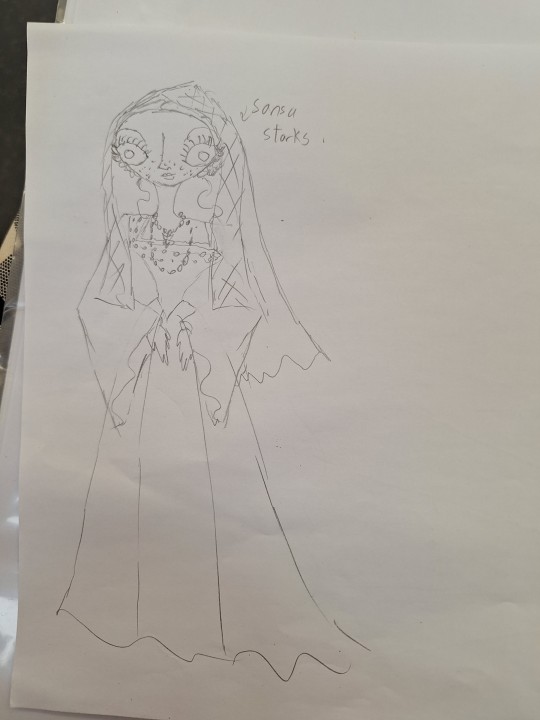
A drawing I made of Sansa Stark in a more historically accurate fashion
It is actually a 15th century rendition of a purple and gold outfit that I really like - with stylistic nods to Elizabeth of York
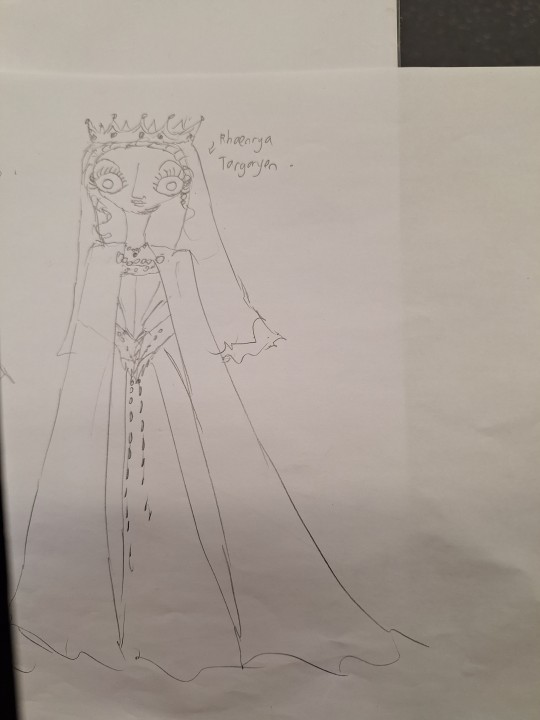
A drawing I did of Rhaenyra Targaryen in a more historically accurate attire
It is a 12th century rendition of a dark blue and gold dragon dress attire that she wore, with stylistic nods to Queen Leah ( Disney animated Sleepinf Beauty ) and Queen Matilda of England
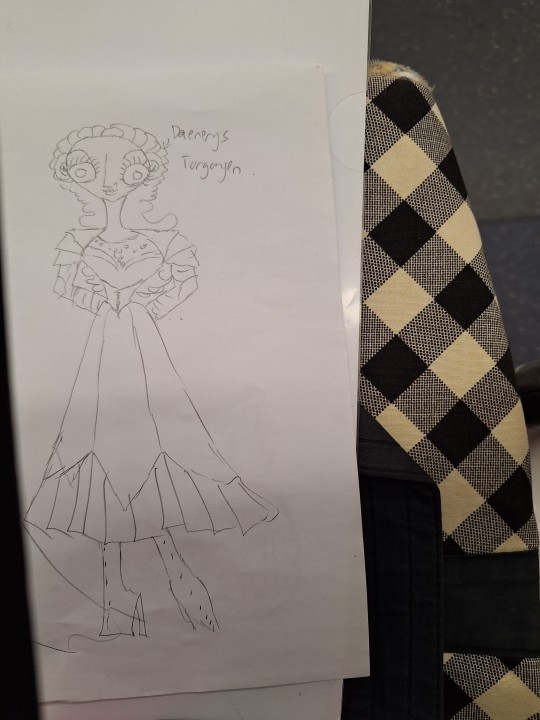
A drawing of Daenerys Targaryen in a more historically accurate attire
Now Daenerys' fashions included beautiful dresses and long skirt armors
I drew Daenerys in a 15th century ladies' armor rendition of a black armor suit of hers that I really like, with stylistic nods to Joan of Arc and Lagertha
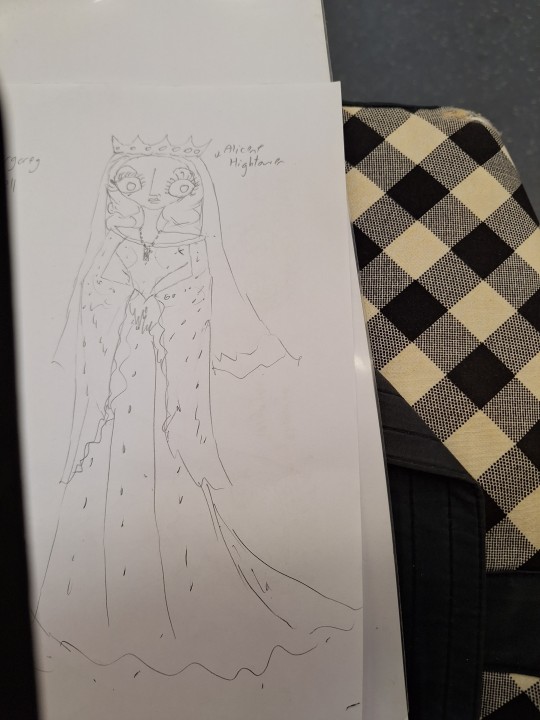
A drawing of Alicent Hightower in a more historically accurate attire
This is a 12th century rendition of Alicent's green and gold attire that I like - with stylistic nods to Queen Elinor from Brave, and Adeliza of Louvain
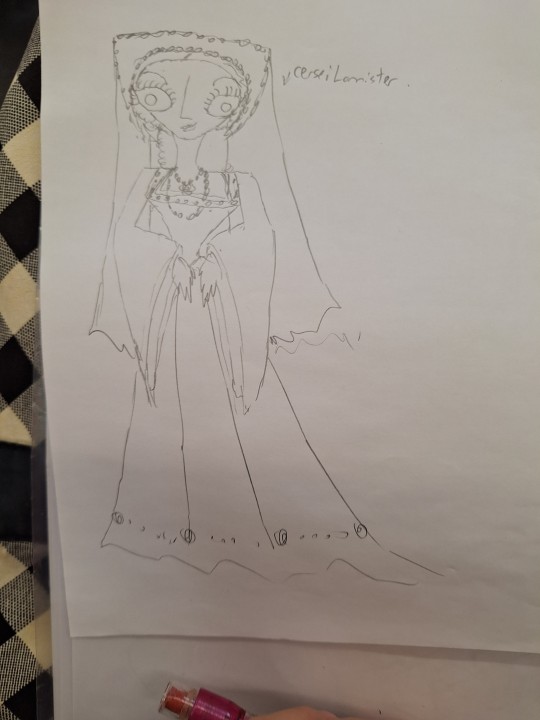
A drawing of Cersei Lannister in a more historically accurate attire
This is a rendition of Cersei in a 16th century rendition of a mahogany and black attire that I've seen her wear ( in my memory ) - with stylistic nods to Caterina di Medici and Mary I Tudor
#game of thrones#GOT historically accurate fashions#12th century fashions#15th century fashions#daenerys targaryen#sansa stark#margarey tyrell#cersei lannister#rhaenyra targaryen#alicent hightower#house of the dragon
14 notes
·
View notes
Text

Bronze gilt ring with blue paste gem, European, 1100-1300
From the Victoria and Albert Museum
#ring#jewellery#fashion#fashion history#history#european#1100#1300#1100s#1200s#1300s#12th century#13th century#14th century
25 notes
·
View notes
Text
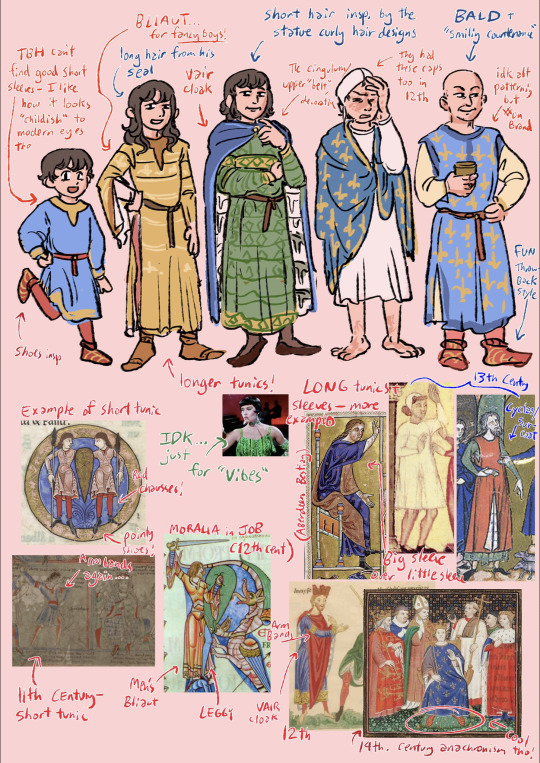
Did a bit of a clothing style timeline thing for my Philip design! tried to stick fairly grounded in the historical sources, although with some fun liberties and inspirations.
#philip augustus#12th century#historical clothing#historical fashion#medieval#middle ages#medieval manuscripts#my art#Philip ii of france#philippe auguste
42 notes
·
View notes
Text
Eitz Castle - Germany
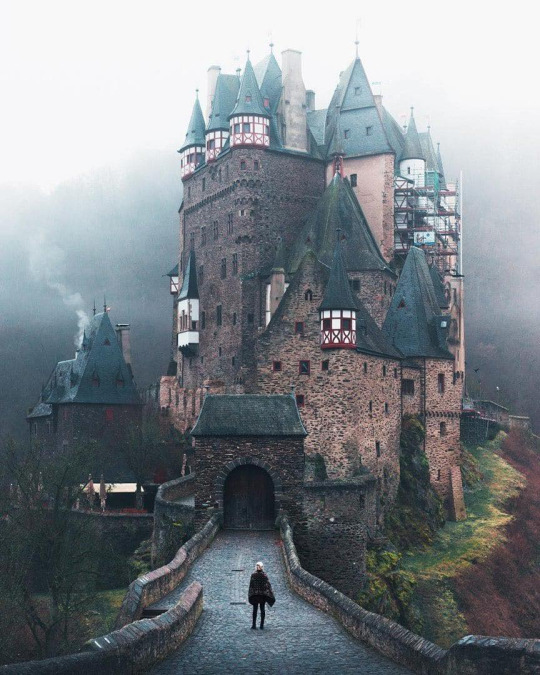
The medieval Eltz Castle located in Wierschem, Germany, and built in the 12th century, has been owned and occupied by the same family for 33 generations (over 850 years).
#vieformidable#design#architecture#interior design#art#photography#fashion#foodporn#interiordesign#eitz#eitz castle#wierschem#wierschem germany#12th century#castle#rich and famouse#lives of the rich and famous#elites#romanesque#gothic#history
50 notes
·
View notes
Text
in honor of arcane s2 i need to remind everyone of the now deleted (i think) dusk & dawn ad in which li ling tells tang xuan about how he finished and enjoyed arcane
#dislyte#dislyte li ling#arcane#arcane s2#please tell me i'm not the only one who remembers this#that ad affected my brain chemistry I think there was just so much information#including but not limited to#tang xuan and tang yun are not on good terms#li ling enjoys goth fashion#the word they used specifically was gothic which ik they just mean goth#but it's fun to think they meant that li ling just really likes mid 12th century western european dress#anyways arcane joined the list of things that are apparently canon to dislyte with other such bangers as looney tunes marvel and coachella
11 notes
·
View notes
Text
#fashion history#historical fashion#11th century#11th century fashion#12th century#12th century fashion#13th century#13th century fashion#14th century#14th century fashion#15th century#15th century fashion#16th century#16th century fashion#poll#fashion
6 notes
·
View notes
Text

I just wanted to paint these sweet fellows in some hot 12th century looks, as you do, so I did. I’d like to submit this as evidence that we should bring the bliaut back into fashion, yes?
#ofmd#our flag means death#gentlebeard#edward teach#stede bonnet#dress history#12th century#bliaut#fashion history#art
17 notes
·
View notes
Text

Ceryse Hightower
That was supposed to be a quick drawing but I'm lazy so I took days to color it. Also, if I had a nickel everytime a second son of House targaryen had a personal familiar beef with house hightower I would have two nickels which isn't a lot but it's weird that it happened twice
#ceryse hightower#house hightower#asoiaf#valyrianscrolls#a song of ice and fire#fanart#my art#fire and blood#pre asoiaf#Can you imagine having to marry a 13 year old kid just to advance your family's ambitions#and worst of all marrying Maegor#Ceryse was probably with migraines 24/7#This is totally based on 12th century fashion#the only regret i have is to not have made double braids#it would've looked better
63 notes
·
View notes
Text
currently feeling a dark age / biblical art typa anguish
#like neck at a 90 degree angle#wailing directly to god#or peeling my own skin off#looking like a dressed up thumb#but sad#alternative#gothic#midwest emo#adhd#bipolar#medieval#medieval fashion#medieval art#dark ages#12th century
3 notes
·
View notes
Text
tfw an ellis peters book has not one, but two, and perhaps as many as three, noble and well-meaning but ill-used men who have taken up false names and identities, and subsequently come to seek shelter, comfort, and resolve in the neighborhood of the abbey
#now obviously hyacinth was bard but if rafe isn't renaud bouchier i'll eat my hat#the hermit also gives every sign of being a Disguised Guy (noble profile revealed from the hood to viewer and reader in the same moment;#narratively positioned so we suspect him of the murder‚ tho i'm still waiting to see if that comes up again early enough that he def isn't#the murderer;#and so on) but i don't THINK anyone has an obvious mysterious father dead in the crusades going spare in this one#so either the hermit is renaud and rafe is actually the guy hunting him after he abandoned his post in cowardly fashion#or the hermit is a different guy whose hints i haven't received yet#or that rare creature. the red herring-hermit. beloved of the salvation-seeking fisherman#box opener#bookbox#Scholars Reveal 12th-Century Shropshire Abbey True Birthplace of Fingerprinting‚ Retinal Scans‚ Identification Cards#''I'm Fucking Sick Of These Noble Irrepressible Wrongly Dispossessed Young Heirs Coming Among Us Disguised As Penitents''‚#Abbot Reportedly Said
2 notes
·
View notes
Text
Not me digging through a fic to find the specific word for a piece of clothing that I couldn't remember the name of so I could google it
Anyways shout out to @handbaskethell for Chapter 7 of An Officer and a Syndic for this specifically -
"His clothing was the finest you’d ever seen him wear. Remarkably, they weren’t all Mitth colors. Instead, he wore a deep violet outer coat with sleeves breaking off at his elbows and trailing down to end in long tippets that nearly came to the floor when his arms were at his side."
'Tippets' was the word I was looking for to describe the thinner version of the bliaut sleeves from the medieval era. But I couldn't remember either word so I spent about an hour just googling shit like "medieval clothing names". All so I could accurately describe the dresses the elves wear in LOTR smh
#read fanfics cause they can teach you about medieval fashion#12th-13th century to be specific#star wars#thrass#thrass fic#thrawn ascendancy
3 notes
·
View notes
Photo
These look like reproduction dresses made by the artisans of the Palio di Legnano's contrade. You can find some of them here, it's the website of the Contrada Sant'Erasmo: http://www.contradasanterasmo.com/?q=content%2Fcostumi
The Battle of Legnano took place in 1176 between Frederick Barbarossa and the Lombard League, aka northern Italy cities. So, these are definitely NOT meant to be clothing from 1300-1400, nor (as I have seen many other tags say) fashion from Byzantium/Constantinople.
Each contrada had several head costumers over the years and so they are using costumes from the 60s, 90s along with more recent ones. While they always were renowned costumers, their approach to history might have varied depending on their personal approach and the knowledge available at the time the costume was made.
One thing we can be sure, is that each and every costume took several artisans countless hours to make, and I'm happy their work is still loved and appreciated today.







Medieval men’s and women’s costumes from the 1300s-1400s
12K notes
·
View notes
Text
Hi medieval fashionistas, I need to know the name of this hat please I can't figure it out if it's a snood

1 note
·
View note
Note
will you please give us examples of resources to look at if we want to learn more about the concept of gender and maybe even transness in Medieval Europe? thanks!
whooooo boy right, there's a lot! I wanna start this by saying that I am very much not an expert, and I only have access to stuff I can find for free and the handful of books I can afford to buy second hand. Most of my research has been around gender as it relates to transness and GNC people. I am absolutely missing stuff, or have forgotten stuff, or simply lack the know-how to find stuff.
There's a few bits I've got on a TBR but haven't read yet - some I've included and some I haven't, depending on the source and how established it is.
Also: this is medieval Europe. The way pronouns are used to describe people don't really align with modern views of sex and gender. Also be aware of old-fashioned language use (for example, some texts talk about "hermaphrodites"). Remember that the way we talk about gender and trans identities is far different to how we even spoke about it 20 years ago.
So with that out of the way... I am chucking this under a read more, because it's long:
---
GENDER
Medieval ideas around gender were different to how we now think about it. The Hippocratic view of gender saw gender as a sort of wet/dry, cold/hot spectrum upon which men were at one end and women the other (and in the middle were intersex people). The male body was seen as hot and dry, and the female as cold and wet. The cold, wetness is what made women try to seek out heat from guys. A lot comes down to humors rather than genitals - if you're hot and dry, that innately means you grow a penis, because the heat sorta forces it out. So the marker is that penis = man, but you only have that penis in the first place because of your hot, dry humor.
Some people believed the vagina was an inverted penis - as in, the penis turned outside in. Some schools of thought believed that both men and women produced "seed", and that both were needed for conception. These thoughts and ideas shifted around a lot.
The Hippocratic view shifted towards Aristotelian ideas around the 12th Century, where the male/female divide was a lot stronger. There were also surgeons throughout all these periods who sought to "correct" intersex genitalia with surgery (how little things change).
This podcast (I've linked to a transcript, because I have more time to read than listen to things) with Dr Eleanor Janega is super interesting. In fact, I'd recommend reading her whole blog, which is fascinating. She also has a book out (but I've not read it so I can't give a yay or nay on that one)
The Meanings of Sex Difference in the Middle Ages by Joan Cadden seems to be a good source on this, but I've not read it so I can't vouch for it 100%.
I've listed below some real people who could fit into our modern interpretation of transness, and the fact that all of these people were only "outed" when arrested or at their death makes me think that there were probably a lot more people at the time who would also fit into this category. It does feel (to me, a layman) that you could rock up in a new town and go "hello I'm Jeff the Man" and people would just accept that.
It's also important to note that the majority of sources I've found are about people we could define as trans men (FTM). I've only found one person who could be described as a trans woman. If anyone out there has more sources for trans women, I'd love to hear them - specifically in medieval Europe/England.
There's also a big discussion to be had around the idea of women dressing as men to achieve a goal. People love getting into arguments about it. My general rule is that if someone lived as X gender, and was forcibly outed against their will or at death, then I feel we can more safely assume that their experience maps more closely onto a trans narrative than it does one of a woman taking on the "disguise" of a man.
---
TRANS & GNC ACADEMIA
Here's some of the sources I've been using that examine medievalism through a trans or trans-adjacent lens.
Trans and Genderqueer Subjects in Medieval Hagiography, Alicia Spencer-Hall & Blake Gutt - a deep dive/collection of essays about medieval religious figures/saints through a trans lens, specifically about cross-dressing figures. Really fascinating, and available on open access.
How to be a Man, Though Female: Changing Sex in Medieval Romance, Angela Jane Weisl - goes into detail about medieval texts in which characters change their sex.
Transgender Genealogy in Tristan de Nanteuil, Blake Gutt - trans theory in the story Tristan de Nanteuil.
Trans Historical: Gender Plurality before the Modern, edited by Greta LaFleur, Masha Raskolnikov & Anna Kłosowska - A great big examination into trans history/gender. I desperately want this book.
Clothes Make the Man, Female Cross Dressing in Medieval Europe, Valerie R. Hotchkiss (book, no online source available) - Another look into women dressing as men and gender inversion.
The Shape of Sex, Leah DeVun (book) - A history of nonbinary sex, 200 - 1400BC. Not read this one yet but it's on my TBR.
In fact, I'd recommend all of Leah DeVun's work, which I'm currently making my way through. I'm currently reading Mapping the Borders of Sex.
The Third Gender and Aelfric's Lives of Saints, Rhonda L. McDaniel - An examination into the idea of a "third gender" in monastic life based around chastity and spiritualism
Erecting Sex: Hermaphrodites and the Medieval Science of Surgery, Leah DeVun - an essay about "corrective" surgery on intersex individuals in the 13th/14th centuries. (I've not fully read this one yet but the topic is relevant)
----
TRANS FIGURES
Joseph/Hildegund (died 1188) - A monk who, upon his death, was discovered to have a vagina/breasts.
Eleanor Rykener (1394) - A (likely) trans sex worker arrested in 1394 (and another source that isn't wiki)
Katherina Hetzeldorfer (killed 1477) - An early record of a "woman" being executed for female sodomy. Katherina dressed and presented as a man, and some scholars read them as a trans man.
Marinos/Marina the Monk (5th Cent) - A monk who was born a woman and lived as a man in a monastery. Marinos was accused of getting a local innkeeper's daughter pregnant. Their "true sex" was discovered upon their death.
-----
ROMANCES* & GENDER
If you're interested in the idea of gender presentation and trans-adjacent stories, I very much recommend taking a look at some contemporary sources. I've tried to take a sort of neutral approach to pronouns for these descriptions, but it's hard to marry the medieval and modern ideas of sex and gender! The titles are all links.
*Romances here means Chivalric Romances: prose/verse narratives about chivalry, often with fantastic elements. Not, like, falling in love Romances.
Le Roman de Silence (13th Cent) - in order to ensure inheritance, a couple raise their daughter as a boy. The baby is called Silence/Silentius/Silentia. The poem features the forces of Nature and Nurture, who argue about Silence's "true" gender - Nature claims they're a girl, and Nurture claims they're a boy. Silence has a variety of adventures, largely referred to in the text as a man with he/him pronouns, and at the end their "true gender" is discovered and, as a woman, they marry the king.
Yde et Olive (15th Cent) - to avoid being married to their own father, Yde, a woman, disguises themselves as a man and becomes a knight. They end up in Rome, where the king marries them to their daughter, Olive. After a couple of weeks, Yde tells Olive about their "true gender", but the conversation is overheard. The King demands Yde bathe with him to prove they are a man. An angel intervenes and transforms Yde's body into that of a man.
Iphis and Ianthe (Greek/Roman myth, but also in Ovid's Metamorphois, which first came to England in the 15th Cent) - Telethusa is due to give birth, but her husband tells her that if the baby is a girl he'll have it killed. When she gives birth to a girl, she disguises the baby as a boy. Eventually, Iphis is engaged to Ianthe. (Incidentally, this is also a really early example of same-sex romance, as Iphis struggles with their love for Ianthe "as a woman"). Before the wedding, Iphis and Telethusa pray at the temple of Isis, who transforms Iphis into a man.
Tristan de Nanteuil (11th/12th Cent) - from the Chanson de geste, after his alleged death, Tristan's wife, Blanchandin/e, disguises themselves as a Knight. Clarinde, a sultan's daughter, falls in love with them. Blanchandin manages to hide their "true sex", but when Clarinde demands they bathe with her to prove they are a man they flee into the woods. There, they meet an angel who asks if they want to be transformed into a man. Blanchandin accepts and he is turned into a man for the rest of the poem. (Incidentally the angel gives him a giant cock. Yes, the text specifies this).
Le Livre de la mutation de fortune (1403) - written in the first person by Christine de Pizan, the poem describes how the narrator is transformed by Fortune into a man after the death of their husband during a storm at sea. They maintain that 13 years after the event, they are still living as a man. (They also mention Tiresias, a Greek mythological figure who was a man transformed into a woman for seven years).
Okay, for now - that's about all I can think of. Happy reading!
327 notes
·
View notes
Text
It's gonna bug me so much when, probably in the next couple decades, Japanese Imperial Household Law changes to allow women to ascend to the throne again and the Western media breathlessly reports that ultraconservative Japan is finally getting with the times...
In actuality Japan has had 8 empress regnants (that is, empresses who actually ruled, as opposed to just being the wife of an emperor; not to be confused with "empress regent" which is something else), including one empress who succeeded another empress (Empress Genshō following Empress Genmei) in a matrilineal fashion. Obviously this isn't great as far as gender equality goes, but it's basically comparable to European monarchies—in fact it's the same number of female monarchs as England has had in roughly the same span of time, given that the pre-Asuka emperors are more or less legendary. There's actually another empress, empress regent Jingū, if you want to count legendary figures. She may or may not be the same person as Queen Himiko of early Sino-Japanese records.
It's maybe worth noting also that the Chrysanthemum Throne has been a basically ceremonial position for most of Japanese history, from the 12th century until today, with the brief exception of the Empire of Japan from 1868 to 1945. But most of Japan's empresses reigned during the Asuka and Nara periods (6th to 8th centuries), when the monarchs were actually politically in power. In fact, during the Nara period just about every other reign was that of an empress.
Anyway, male-only succession and strict patrilineality weren't enshrined in law until the Imperial House Law of 1889 during the Meiji period, as part of the Prussian-influenced Meiji constitution. Certainly both principles had been strong norms prior to this, but they weren't legally enshrined. There's not any sense in which it would be unprecedented for Japan to have an empress, certainly no less precedented than for England to have a queen.
But it's Japan, right? They're uber traditional over there *katana sound effect* *kabuki YOOO sound effect* *salaryman bowing to his stern looking boss stock footage*. So obviously they're behind the enlightened west...
162 notes
·
View notes
Text
So I know almost nothing about Norse art, and this is a bit outside of my usual time period, but how confident are we about the 12th century date on this thing? I ask because
what the heck is this guy wearing?

(this is the only higher resolution image I could find of this)
His garment looks to me like a pourpoint, a type of tight-fitting padded doublet from the 14th century.
The Waterford Charter Roll of 1373 includes illustrations of this type of garment:


Extant example from France which belonged to Charles VI c1380:

I do not know of any pre-14th c garments with the silhouette shown in the Aghadoe Crozier, but if anyone else does, let me know.

The Aghadoe Crozier, a walrus ivory crozier carved in Nordic Urnes style in the 12th century. Discovered near Aghadoe, County Kerry in Ireland.
#art#medieval art#12th century#viking#14th century#anglo irish#historical dress#medieval fashion#dress history#hiberno norse
471 notes
·
View notes